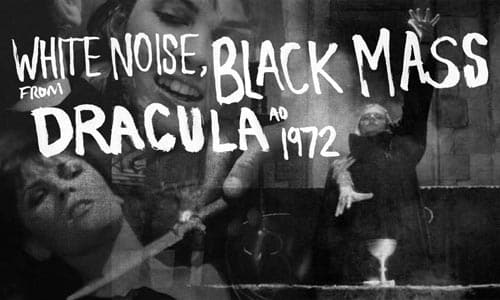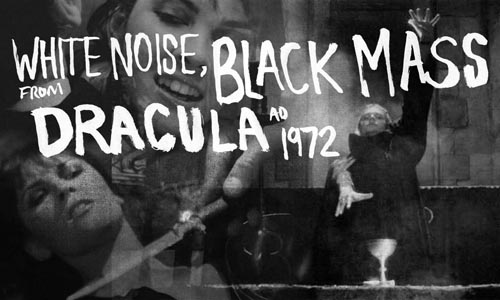DOM COOPER looks at the music from the Hammer vampire classic, Dracula AD 1972

White Noise – ‘Phase Out’ The Visitation, Black Mass: An Electric Storm In Hell
A young couple walks into the crypt of an abandoned church. All around them the stone crumbles and darkness casts long shadows. A giggling man in a white robe leads them towards a circle of people, interrupting the silence of the gothic gloom. They join a small cabal who are knelt round a pentagram chalked upon the stone. Above them a man in black robes stands by an altar that is adorned with an upturned crucifix.
He motions to begin and the man in white switches on a tape machine. Reels turn and the sound of frantic drumming fills the cavernous space. From behind the altar, chalice aloft, the black robed figure starts to call upon demons, chanting names, enacting a black mass. The music starts to warp as electronics merge with the drums. Finally, echoed screams join in.
This is the sound of White Noise’s ‘Black Mass: An Electric Storm In Hell’, and the scene is from the Hammer film Dracula AD: 1972.
White Noise formed in 1968, conceived by David Vorhaus – a classical musician with an interest in electronic music and a background in physics. He was transfixed by both the possibilities of sound and the science behind it. Whilst en-route to a concert, a friend mentioned a lecture on electronic music that was taking place next door. Intrigued, he decided to attend. Brian Hodgson and Delia Derbyshire of the band Delta Unit Plus (who also worked at the BBC’s Radiophonic Workshop) led the talk, in which they discussed methods of creating music through tape manipulation. David was so excited by their words that he persuaded them to collaborate with him on a new venture and the group White Noise was born.
Making music by tape splicing was a slow process, hindered in part by Brian and Delia’s day job, the trio of pioneers convened as often as they could at David’s flat/studio in Camden (dubbed the Kaliedophon) and set about combining their talents. The group’s painstaking efforts paid off when two completed tracks found their way to Chris Blackwell of Island records – who insisted on putting out a whole album by the band, granting them a cheque for £3000 straight away.
‘An Electric Storm’ took a year to finish, but the result is a record of unique oddity. On the reverse of its sleeve are the lines ‘Many sounds have never been heard – by humans: some sound waves you don’t hear – but they reach you. ‘Storm Stereo’ techniques combine singers, instrumentalists and complex electronic sound. The emotional intensity is at a maximum’.
During the recording of the album David’s Camden studio overran with tape – snaking on the floor like worms. His flat emanated strange noises, as machines whirred away – what must have passersby thought?
White Noise’s process of music creation used tape editing, early synthesizers, and effects units. Voices became source material for sounds, sped up and slowed down. Samples were fed in and back out again through the Azimuth coordinator and other bizarrely named equipment.
Soon the label started to get twitchy at the length of time the recording was taking and demanded that it be delivered the next day. The band was left with just 24 hours to create a final piece, when all the other tracks had taken months.
For their finale they drew upon the occult and improvised live in one long take. Incorporating Gregorian chanting, rolling drums and piercing screams. ‘Black Mass: An Electric Storm In Hell’ became the final track on the second ‘Phase Out’ side of the album.
The music is perfect for the dark and heightened manner of the film’s scene. What seems like harmless play-acting and a fun flirtation with the occult becomes more serious as the black mass starts. A close up of a small tape machine sets up the use of White Noises track. It starts midway, at the point when the drum solo is in full freeform flow. On the floor the cabal start to feel the rhythm – they kiss and sway, whilst the black robed man urges them on, ‘ … let it flow into you … ‘. A screeching sounds, and the man calls out to demons, ‘Andras, Grand Marquis of hell and provoker of discord … Behemoth … his satanic majesty … and Count Dracula’. The track notches up a level and the screaming noises start. The ritual heightens; smoke rises and the tape machine spool ends abruptly. The music cuts off, whilst the mass continues to its bloody conclusion.
The 1972 film, a tale of Dracula in modern day, starred Christopher Lee and Stephanie Beacham. Brought back to life by the ritual, Dracula preys upon young swinging London.
Also on the ‘Phase Out’ side of the album is the track ‘The Visitation’, which is a long piece of musique concrète, that took three months to assemble. Inspired by techniques pioneered by Stockhausen and familiar to anyone who has heard ‘Revolution 9’ by The Beatles. The track tells the story of two lovers, who plan to meet secretly, but are torn apart by a motorcycle accident that kills the boy before he arrives. We hear the revving engine and the screech of tires, and finally the crash.
Followed swiftly by a scream from the girl. This gives way to a psychedelic organ sound and singing from the boy. His voice echoes from the beyond to tell her that he will ‘ … go back to my darkness’. He continues, ‘I see you waiting for me’. She cries for him not to go – her sobbing merging with ominous chords. ‘The Visitation’ is the albums dark centrepiece. A kind of audio ‘Psychomania’ meets ‘The Girl On A Motorcycle’.
After the album’s release, Delia and Brian left the group to concentrate on their BBC work, leaving David to carry on with the name. He recorded a further five albums, with the last appearing in 2006.
‘An Electric Storm’ wasn’t commercially successful at the time, but it has grown to be a cult record, influencing many contemporary artists. The ‘Phase In’ side mainly consists of psychedelic sixties pop, albeit in a cut-up electronic way. But the ‘Phase Out’ side contains two great tracks, three months and one day’s work – a cacophony of electronic music as dark as the tape it was created on.



